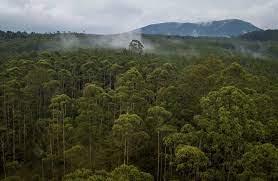Seemingly, often as a result of mapping issues (though this may not have been accidental) Unesco sites and land mapped as Orangutan habitat have been turned into plantations.
The idea that 1/5 of the plantations fall into this category is hard to explain – not surprisingly this is explicitly illegal.

Indonesia is the worlds biggest producer of palm oil, and this has driven the push to deforest large amounts of space that is carbon rich and has damaged large numbers of species of wildlife as well as many communities that have been living in the forest for thousands of years without damaging it.
There are 16.38 million hectares of oil palm plantation. Alarmingly, the government has been setting up increasingly regular amnesties which let the companies get away with it. If you have regular amnesties, it means that companies don’t have to wait long for the government to rubber stamp their theft.
If protected areas can be used for palm oil then they are completely irrelevant. The Indonesian people will pay for this deforestation – it will not improve living standards, in fact looking at what’s happened here and elsewhere deforestation usually benefits someone wealthy (living far away) the locals rarely get well paying jobs, and simply lose the resources that used to sit on their doorstep.
